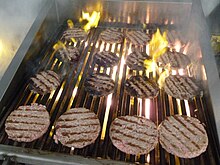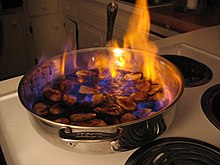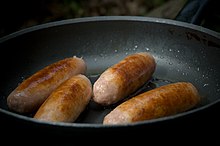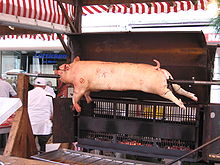This is a list of cooking techniques commonly used in cooking and food preparation.
Cooking is the art of preparing food for ingestion, commonly with the application of differentiated heating. Cooking techniques and ingredients vary widely across the world, reflecting unique environments, economics, cultural traditions, and trends. The way that cooking takes place also depends on the skill and type of training of an individual cook as well as the resources available to cook with, such as good butter which heavily impacts the meal.
A
[edit]- acidulate
- To use an acid (such as that found in citrus juice, vinegar, or wine) to prevent browning, alter flavour, or make an item safe for canning.[1]
- al dente
- To cook food (typically pasta) to the point where it is tender but not mushy.
- amandine
- A culinary term indicating a garnish of almonds. A dish served amandine is usually cooked with butter and seasonings, then sprinkled with whole or flaked, toasted almonds.
- amylolytic process
- Used in the brewing of alcohol from grains.
- anti-griddle
- A kitchen appliance that flash freezes or semi-freezes foods placed on its chilled metal top.[2]
- aspic
- A savoury gelatin made from meat stock or consommé, and often shaped in a mold.[3] Foods served in aspic are suspended in or on top of the gelatin.
- au gratin
- Prepared in the gratin style. Foods served au gratin are topped with breadcrumbs or cheese then browned under a broiler.[4]
- au jus
- Foods served au jus, typically meat or sandwiches, are served with an unthickened sauce made from roast meat drippings, commonly in a separate side dish.
- au poivre
- Foods served au poivre, typically steak, are crusted with ground black pepper prior to cooking.
B
[edit]- backwoods cooking
- A method of cooking without the use of utensils that commonly takes place in remote areas, often in combination with wild or conventional camping.
- baghaar
- A cooking technique used in Pakistani cuisine and Indian cuisine in which cooking oil is heated and spices are added to fry. The oil is then added to a dish for flavoring.
- bain-marie
- A method of cooking where a container of food is placed in or above boiling water in order to heat gradually or to keep warm.[5]
- baking
- barding
- Wrapping meat in fat prior to roasting.[6]
- barbecuing
- Cooking meat or fish slowly over a barbecue grill with indirect heat and smoke.
- basting
- Periodically pouring liquid over food as it roasts.[7]
- blanching
- A technique by which a fresh food such as a vegetable or fruit is briefly immersed in boiling water, removed after a timed interval, and then plunged into iced water or rinsed with cold running water (shocking or refreshing) to halt the cooking process.
- boiling
- boneless
- Unique to the American state of Ohio, boneless refers to a style of cooking chicken breast in which bones maybe present.[8]
- braising
- A combination-cooking method that uses both wet and dry heats: typically, the food is first seared at a high temperature, then finished in a covered pot at a lower temperature while sitting in some (variable) amount of liquid (which may also add flavor).
- bricolage
- The preparation of a meal from whatever ingredients happen to be on hand.
- brine
- To soak a food item in salted water.
- broasting
- A method of cooking chicken and other foods using a pressure fryer and condiments.
- browning
- The process of partially cooking the surface of meat to help remove excessive fat and to give the meat a brown color crust and flavor through various browning reactions.


C
[edit]- candy making
- The preparation of candies and sugar confections by dissolving sugar in water or milk to form a syrup, which is boiled until it reaches the desired concentration or starts to caramelize.
- caramelization
- The browning of sugar, a process used extensively in cooking for the resulting nutty flavor and brown color.
- carryover cooking
- The phenomenon by which food retains heat and continues to cook even after being removed from the source of heat.[9]
- casserole
- Food cooked and served in a casserole dish.
- charbroiler
- A cooking device consisting of a series of grates or ribs that can be heated using a variety of means, and is used in both residential and commercial applications for a variety of cooking operations.
- cheesemaking
- The craft of making cheese.
- chiffonade
- To cut leaves into long thin strips.
- Chinese cooking techniques
- A set of methods and techniques traditionally used in Chinese cuisine.[10] The cooking techniques can either be grouped into ones that use a single cooking method or a combination of wet and dry cooking methods.
- red cooking
- A slow braising technique that imparts a red color to the prepared food, frequently used in Chinese cuisine.
- clay pot cooking
- A process of cooking food in a pot made from unglazed and natural clay.
- coddling
- Heating food in water kept just below the boiling point.[11] Coddled egg may be prepared using this method.
- concasse
- To rough chop any ingredient, especially vegetables. The term is particularly applied to tomatoes, where tomato concasse is a tomato that has been peeled, seeded (seeds and skins removed), and chopped to specified dimensions.
- conche
- A surface-scraping mixer and agitator that evenly distributes cocoa butter within chocolate, and may act as a "polisher" of the particles.
- confit
- A generic term for various kinds of food that have been cooked in grease, oil, or sugar water (syrup).
- consommé
- A type of clear soup made from richly flavored stock or bouillon that has been clarified.
- cooking with alcohol
- Many dishes incorporate alcoholic beverages into the food itself.
- cream
- The butterfat-heavy portion of whole milk that, due to its fat content, separates from the milk and rises to the top.
- creaming
- 1. Combining ingredients (typically butter and sugar) into a smooth paste.
- 2. Cooking meat or vegetables in a thick dairy-based sauce.
- 3. Mixing puréed corn kernels with whole corn kernels in the preparation of creamed corn.
- croquette
- A small roll made of finely chopped meat and/or vegetables that is breaded and fried.
- culinary triangle
- A concept described by anthropologist Claude Lévi-Strauss involving three types of cooking: boiling, roasting, and smoking, usually done to meat.
- curdling
- The breaking of an emulsion or colloid into large parts of different composition through the physico-chemical processes of flocculation, creaming, and coalescence. Curdling is intentional and desirable in making cheese and tofu, but may be unintentional and undesirable in making other foods such as sauces and custards.
- cured fish
- Fish preserved by fermentation, pickling, smoking, or some combination of these techniques.
- curing
- Any of a wide variety of food preservation and flavoring processes used for foods such as meat, fish, and vegetables, by the addition of a combination of salt, nitrates, nitrite, or sugar. Many curing processes also involve smoking, the process of flavoring, or cooking. The use of food dehydration was the earliest form of food curing.
-
The production of Gruyère cheese at the cheesemaking factory of Gruyères, Canton of Fribourg, Switzerland
-
Cooking of Svadbarski Kupus (wedding cabbage) in clay pots, Serbia
-
A coddled egg atop hash
-
Butter being creamed using electric beaters


D
[edit]- deep frying
- A technique by which a food is completely submerged in hot fat or oil (as opposed to ordinary frying, which involves placing the food in a shallow pool of oil).
- deglazing
- degreasing
- dough sheeting
- A technique used in industrial bakeries that involves rolling out dough into a (consistent) dough sheet with a desired even thickness prior to baking.
- dredging
- Coating the exterior of a food with a dry material (such as breadcrumbs) prior to cooking.
- dry roasting
- drying
- Any of a variety of processes by which a food is preserved by removing moisture, often by the use of a modern food dehydrator or by the traditional method of allowing sunlight and fresh air to evaporate moisture.
- dum pukht
- A cooking technique associated with the Awadh region of India, in which meat and vegetables are cooked over a very low flame, generally in sealed containers.
- Dutch oven cooking
- A Dutch oven is well suited for long, slow cooking, such as in making roasts, stews, and casseroles. Virtually any recipe[12] that can be cooked in a conventional oven can be cooked in a Dutch oven. They are often used in outdoor cooking, such as when camping.

E
[edit]- earth oven
- A shallow pit in the ground used to trap heat and bake, smoke, or steam food.
- egg wash
- A preparation of beaten eggs, sometimes mixed with another liquid such as water or milk, which is brushed onto the surface of a pastry before baking.
- emulsify
- To combine two liquids that have a natural tendency to separate (such as oil and vinegar) into one homogeneous mass.
- en papillote
- A technique by which a food is put into a folded pouch or parcel and then baked.
- en vessie
- A cooking method by which a meat or other dish is cooked inside an animal bladder, often a pig bladder.
- engastration
- A cooking method by which the cook stuffs the remains of one animal into another animal.
- engine cooking
- Cooking food from the excess heat of an internal combustion engine, typically the engine of a car or a truck.
- escagraph
- Writing made out of food.

F
[edit]- fermentation
- fillet
- To remove bones from meat or fish.
- flambé
- To pour alcohol over food and then ignite.
- flattop grill
- foam
- A gelling or stabilizing agent in which air is suspended, creating a light, "fluffy" edible substance, e.g. whipped cream, meringue, and mousse.
- food preservation
- canning
- Involves the cooking of foods in sealed cans, among other processes.
- fondue
- fricassee
- frosting
- 1. (v.) The act of applying icing to the exterior of a baked good (such as a cake or cookie).
- 2. (n.) The icing itself.
- fruit preserves
- frying
- To cook food in oil.
- chicken frying
- Battering and pan-frying a piece of beefsteak.

G
[edit]- garnish
- 1. (v.) To add a (typically edible) decorative element to a plate of food prior to serving.
- 2. (n.) The edible decorative element itself. Parsley is a common garnish.
- gentle frying
- glazing
- gratin
- grilling

H
[edit]- Hāngī
- A traditional New Zealand Māori method of cooking food using heated rocks buried in a pit oven still used for special occasions.
- hibachi
- high-altitude cooking
- The process of cooking a food or beverage at altitudes well above sea level, where lower atmospheric pressure causes most foods to cook more slowly and may necessitate the use of special cooking techniques.
- homogenization
- hot salt frying
- huff paste
I
[edit]- indirect grilling
- infusion
- The process of extracting chemical compounds or flavors from plant material in a solvent such as water, oil, or alcohol, by allowing the material to remain suspended in the solvent over time (a process often called steeping). A common example of an infusion is tea, and many herbal teas are prepared in the same way.

J
[edit]- jugging
- The process of stewing whole animals, mainly game or fish, for an extended period in a tightly covered container such as a casserole dish or an earthenware jug.
- juicing
- Julienne
- A culinary knife cut which involves cutting food (typically vegetables) into long thin strips.
K
[edit]
- kalua
- A traditional Hawaiian cooking method that utilizes an imu, a type of underground oven.
- karaage
- A Japanese cooking technique in which various foods — most often chicken, but also other meat and fish — are deep fried in oil, similar to the preparation of tempura, but with a dredge in starch, rather than a liquid batter.
- kho
- A cooking technique in Vietnamese cuisine[13] in which a protein source such as fish, shrimp, poultry, pork, beef, or fried tofu is braised on low heat in a mixture of fish sauce, sugar, and water or a water substitute such as young coconut juice. It is similar to stew.
- kinpira
- A Japanese cooking style that can be summarized as a technique of "sauté and simmer". It is commonly used to cook root vegetables and other foods.
L
[edit]- larding
- The act of threading strips of chilled pork fat through a roast.
- low-temperature cooking
M
[edit]- maceration
- marination
- The technique of soaking a food in a seasoned, often acidic, liquid (known as a marinade) prior to cooking. Marination is generally used as a means of adding or enhancing flavor or tenderizing tough cuts of meat, and the process can vary greatly in duration. It is similar to but distinct from brining and pickling.
- meat cooking techniques
- microwave cooking
- The cooking of food in a microwave oven.
- mincing
- Mongolian barbecue
- mother sauces
- In French cuisine, the five "fundamental" sauces: béchamel, espagnole, velouté, hollandaise, and tomate, as defined by Auguste Escoffier.

N
[edit]- nappage
- nixtamalization
- A process for the preparation of maize (corn) or other grain in which the grain is soaked and cooked in an alkaline solution, usually limewater, and then hulled.
O
[edit]- once-a-month cooking (OAMC)
- Preparing and cooking all the meals you need for an entire month in a single day.
- outdoor cooking
- Cooking in outdoor environments, which often demand specialized techniques and equipment for preparing food. Equipment used includes mess kits and portable stoves, among others.
P
[edit]- pan frying
- Characterized by the use of minimal cooking oil or fat (as opposed to shallow frying or deep frying), typically using just enough oil to lubricate the pan.
- parbaking
- parboiling
- Partially or incompletely boiling a food, especially as the first step in a longer cooking process. Parboiling involves cooking a food in boiling water only until it begins to soften, removing the food before it is fully cooked. The cooking is then often finished by a different method, such as braising or grilling.
- pascalization
- paste
- pasteurization
- flash pasteurization
- pellicle
- A skin or coating of proteins on the surface of meat, fish, or poultry, which allows smoke to better adhere to the surface of the meat during the smoking process.
- pickling
- pig roast
- poaching
- pre-ferment
- pressure cooking
- The process of cooking food, using water or other cooking liquid, in a sealed vessel known as a pressure cooker, which does not permit air or liquids to escape below a pre-set pressure.
- pressure frying
- proofing
- pulling
- purée


R
[edit]- reconstitution
- The process of assembling a palatable food product from processed sources (for example, adding water to concentrated juice or forming meat slurry into chicken nuggets).
- red cooking
- reduction
- rendering
- ricing
- rillettes
- roasting
- robatayaki
- rotisserie
- roux
- A paste-like thickening agent made of equal quantities of flour and fat cooked together to a sandy texture.

S
[edit]- sautéing
- score
- To cut shallow grooves, often in a diamond pattern, into a cut of meat.[14]
- Schwenker
- searing
- A technique used in grilling, baking, braising, roasting, sautéing, etc., in which the surface of the food (usually meat, poultry, or fish) is cooked at high temperature until a crust forms from browning.
- seasoning
- separating eggs
- shallow frying
- shirred eggs
- shrivelling
- shuck
- To remove the outer casing of a food item, such as an ear of corn or the shell of an oyster.
- simmering
- skimming
- slow cooker
- smoking
- smothering
- souring
- sous-vide
- thermal immersion circulator
- spatchcock
- Poultry or game that has been prepared for roasting or grilling by removing the backbone (and sometimes the sternum) and flattening it out before cooking.[15]
- spherification
- steaming
- food steamer
- steeping
- stewing
- stir frying
- straight dough
- stuffing
- An edible food mixture, often a starch, used to fill a cavity in another food item.
- sugar panning
- supreme
- sweating
- The gentle heating of vegetables in a little oil or butter, which usually results in tender, sometimes translucent, pieces.
- Swissing
- syringe
- For injecting fillings in foods.
A home smoker and racks with hot smoked Pacific halibut


T
[edit]- tandoor
- A cylindrical clay or metal oven used in cooking and baking in Southern, Central, and Western Asia,[16] as well as in the Caucasus.[17]
- Tataki
- tempering
- 1. Tempering (chocolate), a method of increasing the shine and durability of chocolate couverture.
- 2. Tempering (cooking), bringing meat to room temperature before cooking; or bringing food up to temperature slowly as in sous vide.
- 3. Tempering (spices), a cooking technique and garnish used in the cuisines of India, Bangladesh, and Pakistan, in which whole spices (and sometimes also other ingredients such as minced ginger root or sugar) are fried briefly in oil or ghee to liberate essential oils from cells and thus enhance their flavours, before being poured, together with the oil, into a dish.
- tenderizing
- A process to break down collagens in meat to make it more palatable for consumption.
- teriyaki
- thermal cooking
- Uses the concept of the haybox whereby placing hay or straw around a cooking pot of heated food the meal continues to cook without fuel.
- thermization
- A method of sterilizing raw milk with heat.
- thickening
- transglutaminase
- A protein binder, called meat glue.
- truss
- To tie the legs and wings of poultry in a way that promotes even cooking.[18]
- turbo cooking
- turkey fryer

V
[edit]- velveting
- A technique which involves coating pieces of raw meat or poultry in a mixture of cornstarch and liquid prior to cooking, frequently used in Chinese cuisine.
- Vietnamese cooking techniques
- Many common culinary terms exist that are unique to Vietnam.
W
[edit]- whip
- wok cooking
- The wok is used in a significant amount of cooking methods.
Z
[edit]- zest
- The colourful outer layer of citrus fruits, often scraped off and used as a flavouring ingredient.
See also
[edit]References
[edit]- ^ Montagné, Prosper (1977). The New Larousse Gastronomique. The Hamlyn Publishing Group Ltd. p. 3. ISBN 0-517-53137-2.
- ^ The Creators of Top Chef (14 July 2010). How to Cook Like a Top Chef. Chronicle Books. p. 157. ISBN 978-0-8118-7486-1. Retrieved 13 December 2012.
- ^ Montagné, Prosper (1977). The New Larousse Gastronomique. The Hamlyn Publishing Group Ltd. p. 55. ISBN 0-517-53137-2.
- ^ Montagné, Prosper (1977). The New Larousse Gastronomique. The Hamlyn Publishing Group Ltd. p. 296. ISBN 0-517-53137-2.
- ^ Montagné, Prosper (1977). The New Larousse Gastronomique. The Hamlyn Publishing Group Ltd. p. 70. ISBN 0-517-53137-2.
- ^ Montagné, Prosper (1977). The New Larousse Gastronomique. The Hamlyn Publishing Group Ltd. p. 84. ISBN 0-517-53137-2.
- ^ Montagné, Prosper (1977). The New Larousse Gastronomique. The Hamlyn Publishing Group Ltd. p. 88. ISBN 0-517-53137-2.
- ^ Bischoff, Laura; Balmert, Jessie (July 26, 2024). "Ohio Supreme Court says boneless chicken wings can have bones". Retrieved December 9, 2024. |publisher=Cincinnati.com
- ^ Turner, Danielle. "Carryover Cooking". Cooking Clarified. Retrieved 27 November 2012.
- ^ 傅, 培梅 (2008), 培梅食譜 [Pei Mei's Chinese Cookbook] (in Chinese), vol. 1, 旗林文化, ISBN 978-986-6655-25-8
- ^ Kipfer, Barbara Ann (2012). The Culinarian: a Kitchen Desk Reference. Hoboken, N.J.: John Wiley & Sons. p. 137. ISBN 9780470554241.
- ^ "Dutch Oven Recipes". The Iron Flame. Retrieved 1 May 2014.
- ^ "The Taste of Tet; It wouldn't be the New Year without kho, the ultimate Vietnamese comfort food", by Andrea Q. Nguyen
- ^ Davidson, Alan (2006). The Oxford Companion to Food. Oxford University Press. p. 703. ISBN 0-19-280681-5.
- ^ How to spatchcock that chicken Archived 2013-06-03 at the Wayback Machine, Knorr
- ^ Raichlen, Steven (2011-05-10). "A Tandoor Oven Brings India's Heat to the Backyard". The New York Times.
- ^ Raichlen, Steven (2011-05-10). "A Tandoori Oven brings India's heat to the backyard". New York Times. Retrieved 2011-05-09.
- ^ Montagné, Prosper (1977). The New Larousse Gastronomique. The Hamlyn Publishing Group Ltd. p. 940. ISBN 0-517-53137-2.
Further reading
[edit]- "Cooking Techniques". Better Homes and Gardens. Retrieved 11 October 2014.
- "Healthy cooking techniques: Boost flavor and cut calories". Mayo Clinic. Retrieved 11 October 2014.
- "Cooking Techniques". The New York Times. 20 August 2014. Retrieved 11 October 2014.
External links
[edit]Wikibooks Cookbook has a recipe/module on
- Culinary Arts Basics: The Fundamentals of Cooking Archived 2014-10-17 at the Wayback Machine. About.com.
- Cooking Instruction





